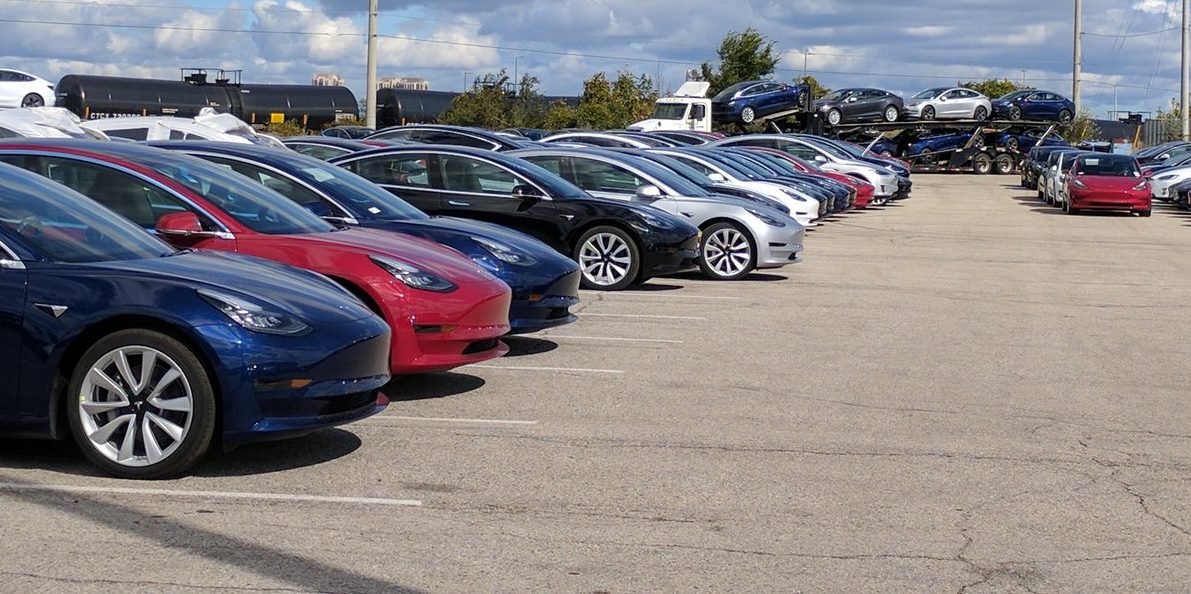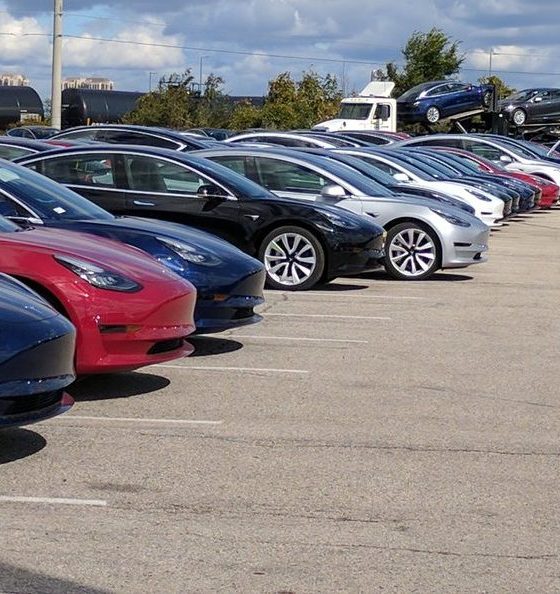

Investor's Corner
Elon Musk hints at Tesla’s profitable Q4, Mid Range Model 3’s int’l release
Tesla stock (NASDAQ:TSLA) is down on early Friday trading amidst news of the company’s new round of layoffs, as well as the impending production ramp of the $35,000 Standard Range Model 3. The rationale behind the 7% job cuts was extensively explained by Elon Musk in an email to Tesla employees, which was shared on the company’s blog.
Musk acknowledged the challenges that Tesla is currently facing, particularly as the company is now setting the stage for the impending release of the Model 3’s most aggressively-priced variant. In his message, Musk noted that in the near future, Tesla’s challenge would lie in developing vehicles and energy products that are attainable for mainstream customers.
“Looking ahead at our mission of accelerating the advent of sustainable transport and energy, which is important for all life on Earth, we face an extremely difficult challenge: making our cars, batteries and solar products cost-competitive with fossil fuels. While we have made great progress, our products are still too expensive for most people,” Musk wrote.
Perhaps most notable in the letter, though, is Musk’s discussion about Tesla’s capability to make a profit. The Tesla CEO noted that he considers Q3 2018’s 4% profit to be the most meaningful in the company’s 15 years of existence. Musk pointed out, though, that the third quarter’s profit was partly the result of a strong push to sell higher-priced variants of the vehicle — the Long Range Model 3 AWD and the Model 3 Performance — to customers in North America. As for Q4 2018, Musk stated that there is a good chance Tesla would be able to make a profit as well, though not in the same level as the third quarter.
“In Q4, preliminary, unaudited results indicate that we again made a GAAP profit, but less than Q3,” Musk wrote.
To help the company maintain profitability, Tesla is adopting Q3 2018’s strategy this quarter, with the electric car maker pushing the Model 3 Performance and the Long Range Model 3 AWD to customers in Europe and China. Musk also stated that Tesla is aiming to deliver “at least the Mid Range Model 3 variant in all markets” starting around May, in order to reach a greater demographic for the electric sedan. Such a system would likely serve Tesla well, at least until the company could start producing the Standard Range Model 3, which starts at the ever-elusive price of $35,000.
In a statement to CNBC, Wedbush analyst Dan Ives notes that Tesla’s international Model 3 push would likely determine the company’s success in the first half of 2019. In the second half, though, Ives stated that Tesla would need to start producing more affordable versions of the electric sedan for the international market.
“If you think about the trajectory, the first half of 2019 is really Europe coming onboard. But then, ultimately, in the second half, you need the mid-range Model 3 to really start to kick in,” he said.
Tesla’s Model 3 ramp might have already reached a level where the company is able to distribute the vehicle to other countries, but the electric car maker is only about halfway done. Tesla eventually aims to produce 10,000 Model 3 per week, to meet the expected demand for the vehicle in the international market. To accomplish this, Tesla continues to optimize its production capabilities in Fremont, while accelerating the construction of Gigafactory 3 in China. The latter is expected to complete initial construction by the end of summer, with the facility manufacturing the first China-made, “affordable” Model 3 by the end of the year.
Elon Musk’s recent letter to Tesla employees can be accessed here.
As of writing, Tesla stock is trading down 8.78% at $316.81 per share.
Disclosure: I have no ownership in shares of TSLA and have no plans to initiate any positions within 72 hours.

Investor's Corner
Tesla stock closes at all-time high on heels of Robotaxi progress

Tesla stock (NASDAQ: TSLA) closed at an all-time high on Tuesday, jumping over 3 percent during the day and finishing at $489.88.
The price beats the previous record close, which was $479.86.
Shares have had a crazy year, dipping more than 40 percent from the start of the year. The stock then started to recover once again around late April, when its price started to climb back up from the low $200 level.
This week, Tesla started to climb toward its highest levels ever, as it was revealed on Sunday that the company was testing driverless Robotaxis in Austin. The spike in value pushed the company’s valuation to $1.63 trillion.
Tesla Robotaxi goes driverless as Musk confirms Safety Monitor removal testing
It is the seventh-most valuable company on the market currently, trailing Nvidia, Apple, Alphabet (Google), Microsoft, Amazon, and Meta.
Shares closed up $14.57 today, up over 3 percent.
The stock has gone through a lot this year, as previously mentioned. Shares tumbled in Q1 due to CEO Elon Musk’s involvement with the Department of Government Efficiency (DOGE), which pulled his attention away from his companies and left a major overhang on their valuations.
However, things started to rebound halfway through the year, and as the government started to phase out the $7,500 tax credit, demand spiked as consumers tried to take advantage of it.
Q3 deliveries were the highest in company history, and Tesla responded to the loss of the tax credit with the launch of the Model 3 and Model Y Standard.
Additionally, analysts have announced high expectations this week for the company on Wall Street as Robotaxi continues to be the focus. With autonomy within Tesla’s sights, things are moving in the direction of Robotaxi being a major catalyst for growth on the Street in the coming year.
Elon Musk
Tesla needs to come through on this one Robotaxi metric, analyst says
“We think the key focus from here will be how fast Tesla can scale driverless operations (including if Tesla’s approach to software/hardware allows it to scale significantly faster than competitors, as the company has argued), and on profitability.”

Tesla needs to come through on this one Robotaxi metric, Mark Delaney of Goldman Sachs says.
Tesla is in the process of rolling out its Robotaxi platform to areas outside of Austin and the California Bay Area. It has plans to launch in five additional cities, including Houston, Dallas, Miami, Las Vegas, and Phoenix.
However, the company’s expansion is not what the focus needs to be, according to Delaney. It’s the speed of deployment.
The analyst said:
“We think the key focus from here will be how fast Tesla can scale driverless operations (including if Tesla’s approach to software/hardware allows it to scale significantly faster than competitors, as the company has argued), and on profitability.”
Profitability will come as the Robotaxi fleet expands. Making that money will be dependent on when Tesla can initiate rides in more areas, giving more customers access to the program.
There are some additional things that the company needs to make happen ahead of the major Robotaxi expansion, one of those things is launching driverless rides in Austin, the first city in which it launched the program.
This week, Tesla started testing driverless Robotaxi rides in Austin, as two different Model Y units were spotted with no occupants, a huge step in the company’s plans for the ride-sharing platform.
Tesla Robotaxi goes driverless as Musk confirms Safety Monitor removal testing
CEO Elon Musk has been hoping to remove Safety Monitors from Robotaxis in Austin for several months, first mentioning the plan to have them out by the end of 2025 in September. He confirmed on Sunday that Tesla had officially removed vehicle occupants and started testing truly unsupervised rides.
Although Safety Monitors in Austin have been sitting in the passenger’s seat, they have still had the ability to override things in case of an emergency. After all, the ultimate goal was safety and avoiding any accidents or injuries.
Goldman Sachs reiterated its ‘Neutral’ rating and its $400 price target. Delaney said, “Tesla is making progress with its autonomous technology,” and recent developments make it evident that this is true.
Investor's Corner
Tesla gets bold Robotaxi prediction from Wall Street firm
Last week, Andrew Percoco took over Tesla analysis for Morgan Stanley from Adam Jonas, who covered the stock for years. Percoco seems to be less optimistic and bullish on Tesla shares, while still being fair and balanced in his analysis.

Tesla (NASDAQ: TSLA) received a bold Robotaxi prediction from Morgan Stanley, which anticipates a dramatic increase in the size of the company’s autonomous ride-hailing suite in the coming years.
Last week, Andrew Percoco took over Tesla analysis for Morgan Stanley from Adam Jonas, who covered the stock for years. Percoco seems to be less optimistic and bullish on Tesla shares, while still being fair and balanced in his analysis.
Percoco dug into the Robotaxi fleet and its expansion in the coming years in his latest note, released on Tuesday. The firm expects Tesla to increase the Robotaxi fleet size to 1,000 vehicles in 2026. However, that’s small-scale compared to what they expect from Tesla in a decade.
Tesla expands Robotaxi app access once again, this time on a global scale
By 2035, Morgan Stanley believes there will be one million Robotaxis on the road across multiple cities, a major jump and a considerable fleet size. We assume this means the fleet of vehicles Tesla will operate internally, and not including passenger-owned vehicles that could be added through software updates.
He also listed three specific catalysts that investors should pay attention to, as these will represent the company being on track to achieve its Robotaxi dreams:
- Opening Robotaxi to the public without a Safety Monitor. Timing is unclear, but it appears that Tesla is getting closer by the day.
- Improvement in safety metrics without the Safety Monitor. Tesla’s ability to improve its safety metrics as it scales miles driven without the Safety Monitor is imperative as it looks to scale in new states and cities in 2026.
- Cybercab start of production, targeted for April 2026. Tesla’s Cybercab is a purpose-built vehicle (no steering wheel or pedals, only two seats) that is expected to be produced through its state-of-the-art unboxed manufacturing process, offering further cost reductions and thus accelerating adoption over time.
Robotaxi stands to be one of Tesla’s most significant revenue contributors, especially as the company plans to continue expanding its ride-hailing service across the world in the coming years.
Its current deployment strategy is controlled and conservative to avoid any drastic and potentially program-ruining incidents.
So far, the program, which is active in Austin and the California Bay Area, has been widely successful.








